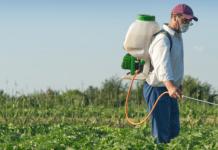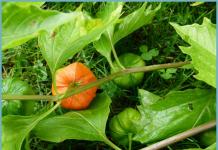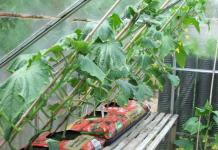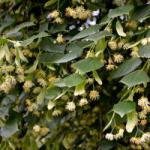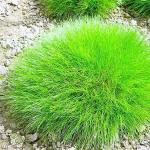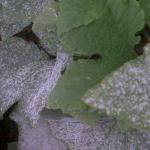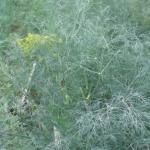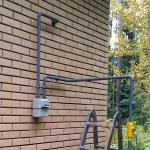The development of plants and the appearance of the crop are often hindered not only by pests, but also by various diseases: powdery mildew, peronosporosis, clamp rot, coccomitosis, anthracnose, rust and many other fungal diseases.
In this article, we will talk about how to deal with powdery mildew and the treatment of downy mildew (transferosis).
Powdery mildew is one of the most common fungal diseases affecting cucurbits. It is usually found in greenhouses and greenhouses, but under favorable weather conditions (high air temperature and humidity) it quickly spreads in open ground.
Powdery mildew control measures and its photo

As you can see in the photo, powdery mildew is a white coating on the leaves and causes the plants to dry out. With severe damage, white spots also appear on the stem and fruits.
The rapid spread of powdery mildew in protected ground conditions is facilitated by sharp fluctuations in temperature, drafts, and watering plants with cold water. Outdoors, powdery mildew spreads rapidly with the onset of persistent hot weather and with the appearance of dew.
The causative agents of the disease persist on plant debris and on weeds.
In open ground, it is recommended to grow varieties resistant to powdery mildew. Plant residues, as well as diseased plants, should be burned or buried in the soil to a depth of at least 40 cm. In autumn, the soil must be carefully dug up and crop rotation observed, that is, plants should be planted in their original place no earlier than after 3 years.
One of the measures to combat powdery mildew is to smear the leaves and stems with ground or colloidal sulfur using a cotton swab. Further, if necessary, the plants should be treated with a suspension of colloidal sulfur or mullein infusion.
To prevent the disease, the temperature regime should be observed. The daytime temperature in the greenhouse should be 24-26 °C during the day, and 20 °C at night.
This fungal disease affects the leaves and stems and which turn yellow and dry out. At the same time, powdery plaque, consisting of fungal spores, is clearly visible on the affected organs. The disease can persist for a long time on plant debris. The development of infection occurs at an air temperature of 20-25 ° C and a relative humidity of 70-80%. To protect legumes from powdery mildew, sources of infection should be destroyed, as well as preventive measures should be taken, which include treating plants with sulfur preparations 2-3 times every 10-15 days.
How to deal with downy mildew and photos of peronosporosis
Peronosporosis affects the leaves of plants. It develops both indoors and outdoors and often leads to the death of plants.

Pay attention to the photo of downy mildew - at first these are oily spots on the leaves, which then turn into brown ones. On the underside, a purple coating of fungal spores is clearly visible. The pathogen can persist in soil and plant debris for 5-6 years. There are no varieties resistant to the disease.
The spread of peronosporosis is facilitated by high humidity and air temperature, therefore, to protect plants in protected ground, an optimal microclimate should be maintained. Air humidity should be no higher than 80%, and air temperature at night should not be lower than 20-22 °C. Downy mildew can persist in the soil and on plant debris, so autumn soil digging should be carried out and plant residues should be burned.
Cucumber is a very ancient vegetable. It appeared 6 thousand years ago. Initially, it was grown in the tropics and subtropics of China and India. This product is a real storehouse of vitamins. It contains vitamins B, C, potassium, phosphorus, iron, magnesium, and also promotes the rapid absorption of animal fats. Therefore, meat dishes go very well with salads or cuts, which include this most useful vegetable. But, sadly, every year growing cucumbers becomes an increasingly difficult process. There are many diseases, and new ones appear that prevent its growth, productivity, and even lead to the death of the plant. Infectious diseases hinder the growth of the plant, whether it grows outdoors or in a greenhouse. Today we will talk about such a disease as peronosporosis.
Symptoms of the disease

Peronosporosis of cucumbers or downy mildew is one of the widespread diseases of this vegetable. This is just the disease that can lead to the death of the plant, as well as significantly reduce its yield. For the first time in Ukraine, this disease appeared in the garden plots of Kharkov in 1972. Until today, breeders have not been able to find a cure for this disease.
It is not difficult to determine peronosporosis on cucumbers. It is expressed in the form of massive brown and yellow spots on the foliage of the plant and affects it at all stages of development. Visually, you can see peronosporosis in cucumbers in the photos posted by gardeners on the Internet.
These spots tend to grow very quickly, which ultimately leads to the drying of cucumber foliage. The disease affects both plants growing in the greenhouse and those grown outdoors.
Moreover, peronosporosis can also spread to nearby plants related to cucumber, such as:
- zucchini;
- pumpkin;
- melons;
- watermelons.

This disease does not affect the fruits of the plant. But dried and fallen leaves, which are a source of nutrition for the fetus with useful substances, become the result of the drying of the entire whip. And this already leads to underdevelopment of the fetus, or to a decrease in yield. Therefore, already marketable fruits are inconspicuous in color and tasteless.
Since peronosporosis is a fungal disease, then its reproduction occurs through the spread of spores, or more precisely, zoospores. Their unique flagellate shape allows them to move through liquids. And each watering of the plant contributes to their favorable reproduction and infection of all new plants.
Even the seeds of the plant can be carriers of the spores of this fungus. And even worse, pests can successfully survive the winter on last year's leaves that have fallen on the ground. Peronosporosis can affect a plant at all stages of its development, from the growth of the first leaves to the ripening period.
But most often downy mildew of cucumber can appear during the period of August, since at this time there is a decrease in night temperature. The plant forms condensation, and this is an ideal moist environment for the reproduction of spores of this disease. This happens especially quickly in a greenhouse, where there is an even more favorable environment for dew. In addition, unbalanced soil can cause downy mildew. For example, the earth lacks phosphorus, potassium, or an excess of nitrogen.

Of course, our breeders are taking measures not only to combat this disease, but also develop plant varieties that will be more resistant to downy mildew. When buying seeds, pay attention to the description of the variety. Gardeners must independently take some measures to avoid the appearance of this disease.
For example, plant early varieties, which makes it possible to harvest before the onset of cold weather, during which peronosporosis develops favorably. Since there is a risk that the seeds are already infected with this disease, they are recommended to be treated with a 0.1% solution of potassium permanganate before sowing.
Since harmful pathogens can remain in the soil for several years, it is recommended that the plants themselves be burned after harvesting, and not added to humus.
This will be a real breeding ground for downy mildew fungi. Another very important point - never plant cucumbers, pumpkins, zucchini every year in the same place. Choose a different site - this will certainly help to avoid an outbreak of a second disease. Now, as for the soil in the greenhouse: after the end of the season and harvesting the plant, you need to remove the top layer of the earth. And then this section of the greenhouse needs to be treated with a 0.1% solution of potassium permanganate.
What methods should be adopted to combat downy mildew

A fairly effective way to fight is the treatment of seeds before planting with biological substances. The drug Trichomerdin in this case is ideal. The main thing is not to overdo it with the dosage, which can lead to deformation of the seeds and, in the future, to inhibition of plant growth. Trichomerdine paste with 40% content of the main preparation is also well used. Its application is carried out in places where the affected leaves and stems of the plant are cut.

And, of course, it is necessary to spray the plant itself on a green leaf. For this, Planriz is well suited based on herbal extracts, which prevents the disease.
Treatment and prevention of peronosporosis of cucumbers is also carried out using chemicals.
If we talk about seed treatment, then preparations containing metalaxyl and mefenoxam are most often used here. As soon as the first signs of the disease appear, fungicides are used. For the purpose of prevention, strobilurin preparations are used: Strobi and Quadris. For the whole season, only two irrigations are carried out. Immediately after treatment with these drugs, sporulation is destroyed and spots on the affected leaves dry out.
As soon as you notice downy mildew on cucumbers, urgent treatment of the plant is necessary.
Now combined fungicides are widely used for this: Copper oxychloride, Efal, Ridomil Gold. These preparations are more suitable for spraying in a greenhouse. On the open field, Acrobat MC has proven itself well.

These substances have their own characteristics, but the main rule is the timely preventive spraying of young plants that already have 3-5 leaves, and further processing at the time when the first fruits begin to appear.
Remember, if you are at least 1-2 days late, the plant may die and cannot be saved. It is also important - do not allow excessive treatment of cucumbers with fungicides, because this is a direct path to the accumulation of pesticides and harmful substances in them. These drugs have the property that stops the growth of fruits, as well as reducing yields.
LetovSadu.ru
Plant diseases: powdery mildew and downy mildew
The development of plants and the appearance of the crop are often hindered not only by pests, but also by various diseases: powdery mildew, peronosporosis, clamp rot, coccomitosis, anthracnose, rust and many other fungal diseases.
In this article, we will talk about how to deal with powdery mildew and the treatment of downy mildew (transferosis).
Powdery mildew is one of the most common fungal diseases affecting cucurbits. It is usually found in greenhouses and greenhouses, but under favorable weather conditions (high air temperature and humidity) it quickly spreads in open ground.
Peronosporosis affects cucumbers, melon, pumpkin, watermelon, as well as plants of the haze family. More often than other plants, parsley, parsnips, celery, dill, as well as cucumbers, zucchini, cabbage, peas, onions, and beets are infected with this disease.
Powdery mildew control measures and its photo

As you can see in the photo, powdery mildew is a white coating on the leaves and causes the plants to dry out. With severe damage, white spots also appear on the stem and fruits.
The rapid spread of powdery mildew in protected ground conditions is facilitated by sharp fluctuations in temperature, drafts, and watering plants with cold water. Outdoors, powdery mildew spreads rapidly with the onset of persistent hot weather and with the appearance of dew.
The causative agents of the disease persist on plant debris and on weeds.
In open ground, it is recommended to grow varieties resistant to powdery mildew. Plant residues, as well as diseased plants, should be burned or buried in the soil to a depth of at least 40 cm. In autumn, the soil must be carefully dug up and crop rotation observed, that is, plants should be planted in their original place no earlier than after 3 years.
One of the measures to combat powdery mildew is to smear the leaves and stems with ground or colloidal sulfur using a cotton swab. Further, if necessary, the plants should be treated with a suspension of colloidal sulfur or mullein infusion.
To prevent the disease, the temperature regime should be observed. The daytime temperature in the greenhouse should be 24-26 °C during the day, and 20 °C at night.
This fungal disease affects the leaves and stems of beans and peas, which turn yellow and dry out. At the same time, powdery plaque, consisting of fungal spores, is clearly visible on the affected organs. The disease can persist for a long time on plant debris. The development of infection occurs at an air temperature of 20-25 ° C and a relative humidity of 70-80%. To protect legumes from powdery mildew, sources of infection should be destroyed, as well as preventive measures should be taken, which include treating plants with sulfur preparations 2-3 times every 10-15 days.
How to deal with downy mildew and photos of peronosporosis
Peronosporosis affects the leaves of plants. It develops both indoors and outdoors and often leads to the death of plants.

Pay attention to the photo of downy mildew - at first these are oily spots on the leaves, which then turn into brown ones. On the underside, a purple coating of fungal spores is clearly visible. The pathogen can persist in soil and plant debris for 5-6 years. There are no varieties resistant to the disease.
The spread of peronosporosis is facilitated by high humidity and air temperature, therefore, to protect plants in protected ground, an optimal microclimate should be maintained. Air humidity should be no higher than 80%, and air temperature at night should not be lower than 20-22 °C. Downy mildew can persist in the soil and on plant debris, so autumn soil digging should be carried out and plant residues should be burned.
To protect pumpkin crops from peronosporosis, they are sprayed with a 0.4% solution of copper oxychloride, a 0.4% solution of polycarbacin or Bordeaux liquid. To prepare it, mix 100 g of lime and 100 g of copper sulfate with 10 liters of water. Before planting in open ground, seedlings are recommended to be fed with ammonium nitrate.
When growing crops in greenhouses, it is important to avoid sudden temperature changes in them.
High air humidity is also harmful to plants under the film.
Photo gallery: powdery mildew and downy mildew (click to enlarge):
|
|
|
|
|
|
|
|
udec.ru
Cucumber disease control

The fight against diseases of cucumbers remains relevant for gardeners in those regions in which there is a predominant cultivation of this vegetable in protected ground conditions. At the slightest violation of agricultural technology and the rules of care, numerous cucumber diseases arise. It can be root rot, powdery mildew, olive blotch, bacteriosis and much more.
Diseases of cucumbers and their treatment: cucumber ascochitosis
Diseases of cucumbers and their treatment require careful preliminary diagnosis. Cucumber ascochyta blight is one of the most dangerous cucumber diseases. It manifests itself in the form of drying of the stem with the appearance of dark perforations (longitudinal cracking), which is especially dangerous in the root part. On the affected areas, small points of pycnidial sporulation are visible. Conidiospores are dispersed through the air, causing damage to healthy plants everywhere or healthy parts of the plant. The source of infection can be seeds, plant residues in the soil, as well as the affected parts of already planted plants. The disease is systemic, that is, the infectious onset develops inside the plant. The pathogen persists on plant debris mainly in the form of pycnidia. A seed infection is also possible. In the latter case, the disease develops from the root collar up the stem, causing its individual parts and lashes to dry out. If the growing conditions of the cucumber turn out to be generally unfavorable, then the infection will go not only up, but also down the root, causing root rot, which leads to a rapid death of the plants. The harmfulness of ascochitosis is expressed in the drying of leaves and stems, which leads to a reduction in the period of fruit formation and a drop in yield.
The development of the disease is facilitated by high air humidity against the background of a general weakened state of plants, while the incubation period can be 4 days. With the intensive development of ascochitosis, a gray mycelial coating appears on the tips of the fruits, which is mistaken for gray rot. In fact, plants weakened by ascochitosis, and in particular fruits, are affected by a secondary infection in the form of sporulation of saprotrophic fungi from the genus Penicillium or from the genus Botrytis.
Often, on cucumber plants affected by ascochitosis, the appearance of cloudy drops of exudate is noticeable, caused by a secondary infection of the cucumber by bacteria from the genus Ervinia.
To combat the pathogen, as a rule, special pastes containing contact preparations (Rovral and Strobilurins) are used. The paste is applied to the affected area with the capture of a healthy part of the plant, and thereby not only affects the pathogenic beginning, but also prevents the formation of spores (sporulation), which will prevent the spread of spores in the greenhouse.
Cucumber Disease Control: Powdery Mildew on Cucumbers
The fight against diseases of cucumbers includes measures aimed at ensuring conditions under which powdery mildew does not develop. Powdery mildew of cucumber mainly affects plants in open and protected ground. The disease manifests itself on the leaves of pumpkin crops in the form of a white or grayish plaque from the mycelium of the pathogen, initially in separate foci on the upper and lower side of the leaf. Then they, merging, gradually spread over the entire area of \u200b\u200bthe sheet. Young leaves are affected first. The leaves turn up, dry up and die, assimilation is disturbed, and, ultimately, the plant dies.
The causative agent of the disease remains on the affected plant debris, from which the primary infection occurs in the form of bagospores. Secondary sources of infection are diseased plants from which conidiospores scatter. During the growing season, the pathogen gives up to 5 generations.
The disease actively develops at high air humidity (90% and above) and sharp fluctuations in temperature (from 15 ° C to 27 ° C). In greenhouses with drafts, the infection spreads quite quickly, causing infection of new plants. Excessive application of nitrogen fertilizers, thickening of plantings, watering with cold water only increase the development of the disease.

Measures to protect against this disease are reduced to the destruction of plant residues, to proper planting (no more than 3 pieces / m2), to optimal fertilization, to compliance with growing regimes, especially in terms of temperature and humidity. When the first signs of the disease appear, it is necessary to sprinkle the plants with mullein infusion: for 10 liters of warm water (25 ° C) take 1 liter of mushy mullein and 1 tbsp. a spoonful of urea. Everything should be thoroughly mixed, strained and sprinkled with a sprayer in the evening.
Mullein infusion can be prepared in another way. To do this, you need 1 part of slightly dried mullein (yesterday's), taken with a thin layer of soil, pour 3 parts of water, keep for three days in a warm place (until bubbles appear), strain, dilute three times and sprinkle the plants in the same evening.
With a strong development of the disease, plants are sprayed with Topaz, k. e. (0.025% working solution).
Protecting Cucumbers from Disease: Cucumber Downy Mildew
No less close attention is required to protect cucumbers from diseases. Among them, downy mildew of cucumbers (downy mildew) is found. This is one of the most dangerous cucumber diseases. It manifests itself first in open ground conditions, especially in years with wet, unstable weather, in particular, with a sharply changing daily temperature variation for 5 days (25 ° C and above in the daytime, and 12 ° C at night), and then it is found in the structures of protected soil. Removing the plastic film from the shelter at this time, the fall of cold rain and watering with cold water - all this leads to the defeat of plants in greenhouses and shelters, as well as to the subsequent intensification of the disease.
On the leaves, signs of the disease appear from above in the form of yellowish angular-circular spots, and from the underside - in the form of a whitish-grayish plaque from the sporulation organs of the fungus. Mature spores are picked up by air currents, spread throughout the garden, shelter or greenhouse, and cause infection of new leaves and new plants. Soon the leaves shrivel, turn brown, dry up and fall off. With high humidity, especially in greenhouses, the disease also manifests itself in the form of leaf rot.
The harmfulness of the disease is expressed in the premature death of leaves, due to which the period of fruit formation is sharply reduced, which naturally leads to a decrease in plant productivity and a drop in yield. At the first signs of the disease, watering and fertilizing are stopped (they should not be carried out at all for 7 days), and the plants should be sprinkled with oxychoma (2 tablets or 20 g per 10 liters of water).
It is possible to actively restrain the development of the disease by spraying with a biological preparation - pseudobacterin (rhizoplan) - on seedlings and at the beginning of fruiting (2 tablespoons per 10 liters of water) in the afternoon. The infection persists on plant debris for up to 7 years, so plant residues must be carefully removed, and every particle of them must be destroyed. It is also desirable to return greenhouses and shelters for cucumbers to their former place of cultivation no earlier than after 7 years.
anthracnose cucumber
Cucumber anthracnose. The disease manifests itself on all above-ground organs of cucumber plants at any age, both in the open field and in greenhouses. Rounded, blurry yellowish-brown spots form on the leaves, which crumble after drying. In humid conditions, pinkish pads from the sporulation organs of the fungus (conidia) can form on the spots. On the stems and petioles, the spots are in the form of ulcerations, depressed and oblong - it is in these places that the stem often breaks, as a result of which the plant dies. On the fruits, the spots are depressed, at first they are small, but as they increase, they turn into ulcers, located on the cucumber in concentric circles. The harmfulness of anthracnose is manifested in a decrease in the area of assimilation and loss of plants, which leads to a drop in yield and a deterioration in product quality.

The development of anthracnose is facilitated by high humidity (90% and above) and high temperature (up to 27 ° C). In this case, the symptoms of the disease begin to appear after 4 days. With a decrease in air humidity, the development of the disease is inhibited, and at air humidity of 55% and below, infection does not occur at all.
Direct sunlight also drastically delays the development of the infection, so the infection most often manifests itself in dense plantings and shaded areas.
The causative agent of the infection is stored on the remains of plants, so greenhouses and beds must be carefully removed from them, followed by their burning.
Also, the onset of infection is also found in seeds harvested from diseased plants. Therefore, seeds should be taken either only from healthy plants, or purchased in specialized stores.
Protective measures here are basically the same as against powdery mildew, peronosporosis and ascochitosis.
Cucumber bacteriosis
Bacteriosis of cucumber (angular spotting). The causative agents of infection (bacteria of the genus Pseudomonas) affect all aboveground organs throughout the growing season. The disease manifests itself especially strongly in film greenhouses or under film shelters. Angular spots appear on the leaves, limited by veins. At first they seem to be oily, and then they become light brown. Droplets of a cloudy liquid appear on the underside of the leaf in places of spots (turbidity is due to the accumulation of bacteria). During rain or improper watering, bacteria with splashes scatter over other leaves and plants, which can lead to massive damage to plantings. During the growing season, bacteria are also spread by wind and insects. The pathogen enters the plant through natural passages (for example, through stomata) or through small wounds caused, including by insects.

In dry conditions, the droplets with bacteria dry up, and the spots become, as it were, covered with a whitish crust (dead tissue may fall out under it). Brown longitudinal spots form on the petioles of the leaves and on the stems, which leads to a suspension of growth, to the fall of the leaves and to the breaking of the stems. Shallow watery colorless spots appear on the fruits, which soon turn into rounded ulcers. Cloudy droplets are also noticeable in them in humid conditions. The affected area does not grow, the fetus becomes ugly.
Harmfulness is expressed in the loss of seedlings (they rot), in a sharp decrease in the area of the photosynthetic surface and, as a result, in the deterioration of assimilation processes, in the lag in growth, as well as in a decrease in yield and deterioration in the quality of fruits. The causative agent of infection persists in plant debris on the soil surface. If the remains are buried or plowed, they rot faster, causing the death of bacteria.
Olive blotch of cucumber

Brown or olive spotting of cucumber. This disease affects fruits of different ages, especially in film greenhouses. Rounded, deep spots (sores) appear on them, first yellowish, then black, the fruits are bent, lose their presentation.
The disease develops strongly with a periodic drop in temperature in the greenhouse to 17 ° C and high humidity (92-97%). For example, in the open field, signs of the disease usually appear towards the end of the growing season with a strong cold snap and the appearance of heavy dew.
The infection persists on plant residues, in the soil, on the internal ceilings of greenhouses, and on inventory.
It restrains the disease, and if carefully performed, it does not allow the appearance of the disease. The next set of measures: the alternation of crops (cultural turnover). Destruction of plant residues; annual disinfection of greenhouses (checkers or sulfur - 100 g/m3); removal of fruits with the first signs of the disease; maintaining the temperature in the greenhouse from the moment of planting the seedlings at a level not lower than 18 ° C; when airing, drafts should not be categorically allowed.
Cucumber root rot: treatment
Root rot of cucumber. Adult fruit-bearing plants in greenhouse conditions suffer the most from this disease. Cucumber leaves, starting from the lower tier, wither, turn yellow and hang. The basal part of the stem and roots turn brown and maculate, while young fibrous roots do not form. Plants dry out and die completely.

Cucumber root rot can be detected on seedlings in the form of browning and thinning of stems and roots, while the cotyledons and young leaves wither, which also leads to the death of plants.
Pathogens, mainly fungi from the genus Fusarium, settle only on plants that are weakened for any reason. As a result of sharp fluctuations in the temperature of the day and night, when irrigating with cold water, when applying excessive doses of nitrogen fertilizers, at high temperatures (35 ° C) and high soil moisture, with a sharp drop in soil temperature below 17 ° C, etc.
Infection can be brought into greenhouses with soil mixtures during soil replacement or when entering the greenhouse in dirty clothes and shoes. In the future, it is stored and accumulated in the soil.
Of the protective measures that limit the infectious potential in the greenhouse, it is necessary to either disinfect the soil (which is very troublesome and expensive) or replace the soil (which, although difficult, is quite affordable). To treat cucumber root rot and increase soil fungistasis in order to prevent root rot, it is necessary to add the Trichodermin biological product (produced on the basis of the Trichoderma fungus, which is a tough antagonist for the Fusarium fungus), into it. It is also necessary to strictly observe the necessary modes of cultivation of plants.
Photo gallery: cucumber diseases (click to enlarge):
|
|
|
|
|
|
|
|
udec.ru
Powdery mildew on cucumbers
Signs of powdery mildew on cucumbers (see photo) are small brown spots covered with white bloom (also called mycelium). At first, a small area is affected, but over time, the disease captures the entire leaf. It gradually becomes dull and dries completely. Cucumber seedlings affected by this disease do not develop, and educated young shoots no longer grow.
How to deal with powdery mildew on cucumbers? Protection is carried out by preparing a solution of weeds. To do this, you need the following material: plantain, coltsfoot, nettle, dandelion, wood lice, Ivan tea. All plants are crushed, placed in a bucket (usually the capacity is 10 liters) and filled with hot water. Next, add one teaspoon of urea, manganese powder, liquid soap and mix everything. And if the question arises - how to treat cucumbers from powdery mildew and other diseases, then the resulting solution is the best option for protecting plants.
In addition to a natural herbal cocktail for powdery mildew on cucumbers, folk remedies are used - whey and a mixture of mullein and urea in a proportion of 10 liters. water / 1 kg of cow manure with the addition of 1 tbsp. spoons of urea.
As a prevention of powdery mildew on cucumbers, fine sulfur powder is used (the soil is pollinated through a three-layer gauze and covered with a film for 3 hours). Also, in the fight against powdery mildew on cucumbers, a decoction of horsetail is used.
Preparation of tincture: 100 gr. dried or 1 kg of fresh horsetail is infused for about a day in 10 liters of water, then boiled for about 2 hours. After boiling, the broth should be cooled and diluted with water in a ratio of 1:5.
Thus, it is possible to significantly improve the process of growing cucumbers. Diseases are eradicated, and the soil becomes quite suitable for the safe growth and fruiting of plants.
Advice! In order to prevent the disease, diseased leaves and shoots should be burned immediately. Throwing them to the edge of the garden or garden is not recommended.
How to deal with downy mildew (downy mildew)?
The main sign of downy mildew on cucumbers (see photo) are yellow-green spots that cover most of the leaf. They are also mistaken for traces of acid rain. A purple-gray coating appears from the bottom of the leaf, as a result of which it dries completely and crumbles. Downy mildew of cucumbers affects plants regardless of age. It is typical in most cases when growing cucumbers in open ground.
Prerequisites for the emergence and development of peronosporosis are high humidity and air temperature up to 16-180C. The disease develops from small droplets on a leaf.
Spores are able to maintain their dangerous activity in the soil for a long time, so it is very difficult to deal with them. If peronosporosis or downy mildew appears on cucumbers, then control measures should include the use of certain preparations containing copper (Bordeaux liquid, Ridomil Gold, Oxyhom). These funds are effective as a prophylactic agent.
If cucumbers are affected by downy mildew, then the treatment is carried out with the drug "Rizoplan". It is based on living cells of some bacteria. They are absolutely harmless to humans, but fatal to downy mildew spores. The drug also does not accumulate in the soil, but decomposes immediately.
In addition to traditional preparations, you can apply from downy mildew on cucumbers and a folk remedy - whey. Leaves are sprayed with it.
How does olive blotch (cladosporiosis) appear on cucumbers?
The occurrence of olive spotting of cucumbers (see photo) should be observed in the second half of summer, when the cucumbers have already fully formed a bush. Olive blotch appears on fruits in the form of olive (brown) color spots with bloom. The disease spreads rapidly and if not treated, you can lose the entire crop.
This type of disease is more typical for greenhouse conditions. Cladosporiosis spores are resistant to the microclimate of the greenhouse, so the fight against this disease should be started immediately.
If olive spotting of cucumbers is observed, then control measures should include thorough wiping of all surfaces of the greenhouse with a disinfectant that does not contain chlorine. In no case do not water the cucumbers with cold water, and at the first detection of the disease, you should generally stop watering the plant for 3-4 days.
Treatment of cucumber disease in the open field is carried out through the use of solutions that contain copper - Bordeaux liquid with the addition of liquid soap.
In order to prevent the occurrence of olive blotch, a change of crops in the affected areas should be carried out.
What is an ordinary cucumber field mosaic?
Ordinary cucumber mosaic (see photo) most often develops in open soil. Signs of the disease are yellow-green spots in the form of a mosaic. With the development of the disease, the leaves of cucumbers curl, fade, dry out and crumble. The fruits become very pimply. Under the influence of the disease, the immunity of the plant is so weakened that with a sharp decrease in air temperature, the bush simply stops growing and soon dies.
The danger of this disease lies in its resistance to cold. Spores of an ordinary field mosaic easily survive winter and cold in the root systems of reserve plants (thistle, quinoa, wood lice, bindweed, wheatgrass). These are hard-to-remove weeds, so it is very difficult to fight this virus. You can apply the method of growing cucumbers in plastic bottles. It is absolutely not complicated and plants are not affected by field mosaic in 94% of cases.
How to spray cucumbers from the disease? With an ordinary cucumber mosaic, the treatment consists in spraying the bushes with whey. In especially severe cases, this is done with a concentrated substance, and in preventive measures and in the initial stages of the disease, serum should be diluted with water in proportions of 1: 2. Treatment of cucumbers for diseases with folk remedies very often gives a positive and lasting result.
Green and white mottled mosaic
Green and white cucumber mosaic (speckled) is one of the most common infections. Signs of the disease are wrinkled leaves with blown out places, and areas with a green or white color also appear. Spots become white in a progressive stage. In this case, it is very difficult to fight the disease.
At the advanced stage, cucumber bushes dull their growth. Leaves weaken and begin to fade in places. The fruits, accordingly, become very soft, and their taste qualities deteriorate. An outbreak of the disease can be provoked by a sharp increase in temperature from 220C to 300C.
This dangerous viral disease is transmitted through an untreated tool, plant remains, and simply persists in the soil. To combat this disease, summer residents choose varieties that are resistant to the disease (mainly hybrids for open or closed ground).
The best measure to get rid of this disease of cucumbers is care. It is necessary to remove the affected shoots and leaves in time and burn them immediately. Also, for prevention, you can spray the bushes with a light solution of whey.
How to deal with gray cucumber rot?
Gray rot on cucumbers (see photo) is a type of viral disease that manifests itself during their active fruiting. A gray coating may appear on leaves, stems and fruits, especially in internodes. The most favorable environment for its development is a densely planted area of \u200b\u200bthe garden or garden.
The fact is that cucumbers that grow in close proximity to each other begin to rot due to the inability to develop in close quarters.
How to deal with gray mold on cucumbers? The therapeutic measure is the timely removal of diseased leaves and entire sections of the stem. In some cases, it is necessary to remove the entire hive. The fight against gray rot on cucumbers also consists in applying to the wounds of the removed sheets of a specially prepared substance (chalk with potassium permanganate). The consistency of such a remedy should be viscous and have a light pink tone.
Root rot of cucumbers
The danger of cucumber root rot (see photo) is that the signs of the disease are not immediately visible, since it affects the root system of the plant. The first sign of this disease is a sharp wilting of the bushes. In this case, you can not start watering the plant, this will harm it even more.
How to save cucumbers from root rot? In the early stages of the manifestation of the disease, the root system should be slightly exposed (for this you need to slightly loosen the soil around it). Treatment of root rot of cucumbers consists in sprinkling the affected parts with a specially prepared composition (charcoal, chalk and ash). A solution of copper sulfate and copper oxychloride can also help with root rot of cucumbers.
After therapeutic measures, the roots and part of the stem should be sprinkled with clean, dry and unaffected soil. Watering can be started at the first sign of improvement in plant growth.
main-dacha.ru
Why does powdery mildew appear on cucumbers?
Vjacheslav Goryainov
Great harm to cucumbers, especially when grown indoors, is caused by pests and diseases. This is mainly due to the specific features of their cultivation in small amateur greenhouses. This is the lack of an elementary crop rotation, a limited set of cultivated crops, the lack of the necessary drugs and basic skills to deal with major pests and diseases.
Powdery mildew is a widespread harmful disease of cucumbers in greenhouses. It causes especially great harm at high humidity, especially with frequent dew and sharp temperature fluctuations, poor ventilation, cold water irrigation, etc. The disease causes a strong decrease in yield and a significant reduction in the growing season.
The disease often affects fruit-bearing plants. First, on the upper side of older leaves, and then on the lower side, rounded spots are formed, covered with a white powdery coating. Then they increase in size, appear on the underside of the leaves, covering the entire leaf. Diseased leaves become light, brittle, wrap up and quickly dry out. With severe damage, plaque may also appear on petioles and stems. At the same time, individual lashes can even dry out.
Powdery mildew develops especially quickly if there is drip moisture in the greenhouse. That is why often the first foci of the disease appear near the windows, broken glass, where droplets of moisture fall on the surface of the leaves. In greenhouses, the disease progresses rapidly at a temperature of 20-25°C and a relative humidity of more than 80%.
It is difficult to defeat powdery mildew, but it is possible if you use the entire set of preventive and eradicating agents.
First of all, this is the observance of garden crop rotation when growing cucumbers in open ground, and in closed ground, if there are two greenhouses, alternately growing cucumbers and tomatoes in them. At the same time, it is very important to grow varieties and hybrids of cucumbers that are relatively resistant to powdery mildew. By the way, the set of such varieties in trade is quite solid. But let's be honest and let's try to remember - did it interest us when choosing a variety?
Of no less importance is the cleaning of greenhouses and greenhouses in the fall from plant residues and weeds and their immediate destruction, followed by disinfection of the entire greenhouse with bleach or fumigation with sulfur briquettes. Deep autumn digging of the soil is also of great importance.. .
When the first signs of a powdery coating appear on the leaves, they must be sprinkled with a solution of mullein: for 10 liters of warm (25 ° C) water, take 1 liter of liquid mullein and 1 tbsp. a spoonful of urea. The solution should be well stirred, filtered and sprayed on the leaves in the morning in warm weather. Leaves should be processed from the sprayer both from the bottom and from the top. Pollination of plants with finely ground sulfur helps. To do this, pour sulfur into a bag of three-layer gauze and pollinate the plants during the day in sunny weather at an air temperature of 23 -28 ° C. When processing in a greenhouse, it is necessary to close the windows and doors, and cover the cucumbers in the garden in the open field with a film for 2 hours. A good result is obtained by spraying plants with a solution of potassium permanganate (1.5 g per 10 liters of water). An effective way against powdery mildew is spraying plants with colloidal sulfur, 40 g of the drug per 10 liters of water. In this case, the processing is carried out in cloudy weather.
A more reliable way to deal with powdery mildew on cucumbers is spraying with Topaz. To do this, take 1 ampoule (2 ml), diluted in 10 liters of water (room temperature), stir and pour into a fine spray sprayer.
Spraying is carried out both at the first signs of the disease, and for prevention. Spray cucumbers 2 times. The first spraying is carried out when 8-10 true leaves appear, the second - at the beginning of flowering (about 10-12 days after the first).
Oksana Sedakova
Signs of the disease: a white coating appears on the leaves, which spreads rapidly, as a result, the leaves become white (as if sprinkled with flour), then they dry out and the plants die. And the causes of the disease are that at a sharply changing temperature (25 during the day, and 12-15 at night), when watering with cold water or during cold rain, the causative agent of the disease develops intensively. Control measures: spray your plants with drugs such as TOPAZ or FUNDAZOL. Good luck!
In the early 1980s, a strange phenomenon was noticed on state farm fields in the center and south of Russia. The wide leaves of zucchini, pumpkins, cucumbers and gourds were covered with brown dry spots of almost regular square shape. The same phenomenon was observed in suburban summer cottages: the leaves of pumpkin crops became covered with spots, the plants slowed down their growth and soon died.
Summer residents, without thinking twice, attributed everything to acid rain. And agronomists, after carefully studying the leaves, saw a familiar white coating on their lower part - and decided that this was a new form of powdery mildew. However, the usual tactics of struggle did not bring results - the crop of cucumbers and zucchini was completely lost. This went on for several years. The farms had to abandon the cultivation of pumpkin.
Peronosporosis - not dew and not spotting
Next, the process of capturing the host organism occurs. Zoospores germinate with mycelium, which penetrates the vessels of the leaves and penetrates the stem, roots and seeds. And only then, when the plant is already riddled with mycelium, does it begin to come out on the underside of the leaves, giving a slightly noticeable whitish fluff. This is what confused those who first encountered peronosporosis:
[!] White plaque on the leaves - initial stage of infection with powdery mildew, but - in the case of downy mildew, white bloom forms in ultimate stage when the plant is already incurable
The rate of infection is literally a record - an adult plant captures the mycelium of the fungus in three days. Young seedlings are affected in less than a day. In this case, in general, the plant may look quite healthy.
The overgrown mycelium proceeds to the next stage of reproduction. On the underside of the leaves, multiple filaments with fruiting bodies appear from the stomata. Outwardly, this is very similar to powdery mildew, but without the characteristic dark dots (conidiophorous bags). The fruiting bodies of peronospores are very small and indistinguishable to the naked eye. The color of the plaque varies from white to gray-violet. Zoosporangia can appear many times per season and produce dozens of zoospore generations.
When the fruiting mycelium finally depletes the leaf cells, spots appear on its upper side. Most often they have a dry brown surface that peels off. If there is a lot of mycelium in the plant, then the spots merge together, leaving only the veins intact. The leaf eventually completely wrinkles and crumbles.

Some species of peronospores form yellow weeping spots resembling a viral infection, or very similar to a black spot lesion. Due to such a variety of symptoms, the diagnosis of downy mildew is a rather complicated matter.
In the remains of a dead leaf, mycelium exists for some time, which is capable of infecting. If particles of dry leaves fall on a healthy plant, the cycle will begin again. In addition to the mycelium, oospores are formed in plant residues - a wintering type of spores. The oospores are quite large, light-colored and clearly visible in the dry tissues of the leaves. Often it is the presence of oospores that allows us to conclude that the plant died from peronosporosis, and not from another infection.
There is an opinion that peronosporosis was introduced into agriculture by insect pests. Zoospores, although mobile, are not able to independently overcome long distances. However, flying insects are able to carry the pathogen anywhere. Peronosporosis carries aphids, whiteflies and other pests. Primitive fungi often exist in the body of small insects, without causing harm, but only using them as transport.
A threat to indoor flowers
Various types and subspecies of peronospores can be dangerous for indoor plants. In particular:
- Peronospora destroying (Peronosporadestructor) affects almost all bulbous plants;
- Peronosporasparsa, in various variations, attacks roses, wisteria, begonias and many other flowers;
- Pseudoperonospora - the species specializes in palm trees and other monocots;
- Saintpaulias and other plants with densely pubescent leaves affect two genera at once - Peronospora and Plasmopara.
However, in well-maintained home collections, flowers are rarely affected by downy mildew en masse. Most outbreaks occur if contaminated soil has entered the containers. Especially dangerous are heavy acidic soils or those taken near farmland.
Seeds and cuttings bought from the hands can also carry the infection. Planting and sowing material from the store is practically safe: large flower farms have long learned to deal with downy mildew.
Downy mildew prevention measures
- prevention of outbreaks of peronosporosis is about the same as in the case of ordinary powdery mildew:
- elimination of thickening in plantings;
- ventilation of the room;
- fight against insects - distributors of pathogenic fungi;
- warming up the soil before planting and sowing indoor plants;
- disinfection of seeds with a solution of potassium permanganate;
- treatment of containers after diseased plants - best of all with soda;
- spraying plants, both sick and nearby, with copper-containing preparations - Thanos, Ridomil Gold, systemic - Vectra, Topaz and the like. In this case, the dosage should be carefully observed - copper compounds are toxic to plants;
- ash infusion is effective if it is used before the mycelium penetrates the plant. It will destroy the zoospores that are on the surface;
- milk whey with iodine (1-2 drops per liter) - reduces the infectious mass and simultaneously strengthens the tissues of the plant.
[!] Sulfur-containing preparations do not help against peronosporosis.
How to deal with downy mildew
Unfortunately, in most cases, peronosporosis gives external symptoms already at a late stage. You can weaken the course of the infection by applying systemic fungicides and get seeds from the plant, subsequently disinfecting them.
The most effective control measure can be considered the breeding of disease-resistant varieties and hybrids. Like true powdery mildew, each downy mildew pathogen is rigidly attached to a specific host and is not always able to switch to a new plant species.
As an effective tool at hand, you can use antibiotic solutions, incl. expired: penicillin and terramycin - 100 units / ml, streptomycin - 300 units / ml, diluted with water 1:10 and sprayed on the undersides of the leaves. Also applicable are all drugs intended to combat fusarium.
***
Why peronosporosis did not conquer Central Asia.
The pathogen is absolutely unstable to heat - it stops reproducing at + 30 °C and completely dies at + 40 °C.
If you heat the soil, as well as the seeds and cuttings of plants to about + 60 ° C for thirty minutes, downy mildew is guaranteed to die. Such a short-term increase in temperature will not harm even many of the mature plants, especially such as aloes, palms and the like. So it’s worth trying to arrange “Tashkent” for downy mildew, it is quite possible that the result will be encouraging.
Downy mildew is akin to an epidemic: it can easily leave us without a crop of cucumbers, zucchini, pumpkins. In the beds with this disease, you need to start fighting in the fall. What measures should be taken so that in the spring it does not return again?
Peronosporosis, or downy mildew, affects the pumpkin family: cucumber, melon, squash, zucchini, pumpkin, watermelon. The first symptoms appear already in the phase of 5-7 leaves, and from mid-summer the disease can become an epidemic. The disease develops on the surface of a moist leaf, 5-10 days after infection, yellowish spots appear, limited by veins. With sharp fluctuations in day and night temperatures, combined with rain or heavy dew, the spots become numerous and merge. On the underside of the leaf, a grayish-purple coating is formed, consisting of spores - they spread the disease around the site. Later, the leaf turns brown and dies.
During rainy seasons, 10-15 generations of summer zoospores (two-flagellate cells living in water) can develop. They die within a few hours if they fail to penetrate the leaf tissue. Therefore, the absence of water drops on the leaf is the best prevention of the disease.
The causative agent of downy mildew overwinters in the form of oospores - this is the dormant stage with a thick shell. They form inside the affected tissues at the end of the season and remain in the soil or in plant debris, remaining viable for several years. Reducing the number of oospores in the soil is the main task of the gardener in the fall.
What to do in autumn
At the end of the season, after harvesting, the plants should be sprayed with contact preparations against peronosporosis. After 3-5 days, collect plant debris and burn them. Do not dig the earth! If next year another crop is placed on such a bed, then the probability of infection of cucumbers will decrease sharply.
Disease prevention
- Choose resistant varieties and hybrids.
- Well ventilate greenhouses.
- For prevention, spray cucumber plantings with systemic preparations.
- In greenhouses, maintain an optimal growing regime.
- It is advisable to use drip irrigation or refuse evening watering - the leaves of the plants should not be covered with dew and get wet during the watering process.

One of the most common diseases is peronosporosis, or downy mildew- a fungal disease caused by the lower fungus Peronospora. The causative agent of the disease can persist in plant debris, seeds and become more active in wet conditions - during rains or just in wet weather.
Listen to article
Downy mildew - description
In plants with peronosporosis, yellowish-green oily spots of an angular or rounded shape, limited by veins, appear on the upper side of the leaves. Then, a barely noticeable gray-purple bloom forms on the underside of the leaves. The spots gradually increase, merge, and as a result, the leaves droop, wrinkle and dry, crumbling into fragments that can infect neighboring plants. Due to the death of the leaves, the process of fruit set and their development slows down - the fruits become pale and tasteless. With a strong defeat, the disease downy mildew can destroy the plant in a very short period of time.
Downy mildew affects all groups of cultivated plants - vegetables, garden and indoor flowers, fruit trees and shrubs. During one growing season, the pathogen forms up to 20 generations and sprays millions of zoospores. The spread of downy mildew is facilitated by insect pests - whiteflies, aphids and others.
Downy mildew control measures
Treatment of peronosporosis
Treatment of peronosporosis is carried out with a solution of sulfur - 50-80 g of the substance is dissolved in 10 liters of water, and both plants and the soil under them are treated with this composition. Treatment of downy mildew is also carried out with fungicides Fitosporin-M, Gamair, Planriz, Alirin-B or Gliocladin, treating them with garden or vegetable garden solutions at intervals of two weeks. A month before harvesting, it is advisable to stop treatment with fungicides and switch to folk remedies for downy mildew.
However, the fight against peronosporosis is not only the treatment of plants with medicinal preparations. You can save your site from infection by observing the agrotechnical conditions for growing plants and taking preventive measures against diseases and pests.

Downy mildew - prevention
Plant protection from peronosporosis begins with preventive measures. You can significantly reduce the risk of damage to your plants by fungal diseases if you clean the site of plant debris in the fall and dig the soil to a depth of 25-30 cm. If during the past growing season you had to get rid of harmful microorganisms, in the spring treat the soil in the area with a one percent solution potassium permanganate or a two to three percent solution of copper sulfate, then be sure to dig the soil. You can also disinfect the soil with biological preparations Fitosporin-M, Gamair or Alirin-B.
For prophylactic treatment of plant peronosporosis in early spring, before bud break, a seven percent urea solution, a ten percent ammonium nitrate solution, or a fifteen percent ammonium sulfate solution are used. In the green cone phase, the trees are treated with a 1% solution of Bordeaux liquid, then spraying with this preparation is repeated after flowering and in the ovary formation phase. Also, after flowering, for spraying plants, the biological preparations Integral, Gaupsin, Mikosan, Gamair, Fitosporin-M or Planriz are used - a drug for peronosporosis, which can be used to treat plants even a day before fruit removal.
To reduce the risk of plant diseases, it is very important to observe crop rotation on the site, returning crops to their original places no earlier than after 3-5 years. If you grow a crop in one place from year to year, this will lead to the accumulation of infection in the soil and, as a result, to the weakening and disease of plants.

Treat the seeds before sowing - keep them for a quarter of an hour in a thermos with water at a temperature of 45-50 ºC or in a one percent solution of potassium permanganate. The roots of seedlings before planting in open or protected ground for 2-3 hours, dip in a solution of Trichodermin, prepared according to the manufacturer's instructions. Grow disease-resistant varieties and hybrids. Do not compact plantings, but thin out the crown of trees and shrubs in a timely manner - the fungi are comfortable in cramped conditions. Follow all agrotechnical requirements, carry out plant care activities on time. Severely diseased specimens should be immediately removed and burned.
Downy mildew on vegetables
Downy mildew of cucumbers
Most often, peronosporosis disease manifests itself on cucumbers in August - just at this time, the night temperature begins to drop, and condensate forms on cucumbers, which is an ideal breeding ground for peronosporosis spores. Downy mildew on cucumbers can occur against the background of a lack of potassium, phosphorus or excess nitrogen in the soil. Peronosporosis of cucumbers develops especially rapidly in a greenhouse, where there is a favorable environment for the formation of dew. What are the measures to combat downy mildew on cucumbers? When the first signs of the disease are found, treat the plants in the greenhouse with a solution of fungicides Ridomil Gold, Efal, or copper oxychloride. In open ground, it is better to spray cucumbers with Strobi, Quadris or Acrobat MC preparations.
However, remember that if you are late for a couple of days, you may no longer have time to save the plants from death, so at the beginning of the growing season, draw up a plan of preventive measures and follow it strictly. If you take preventive measures, your cucumbers will be protected not only from downy mildew, but also from most fungal diseases. To protect cucumbers from downy mildew, you need:
- grow cucumbers resistant to downy mildew - for example, varieties Katyusha, Kumir, Photon, Zodiac, Rodnichok, Debut or Golubchik;
- carry out preplant heat treatment of seeds for 15 minutes in water at a temperature of 50 ºC;
- prepare the soil for planting - treat the soil with Fitosporin-M or Gamair and then carry out deep digging;
- in the greenhouse it is necessary to regulate the humidity of the air. As soon as spots begin to appear, the affected leaves must be removed immediately, leaving no petioles;
- increase the resistance of plants to pathogens by applying potassium-phosphorus fertilizers. Do not oversaturate the soil with nitrogen;
- treat cucumbers on a green leaf with a solution of the Planriz biological product, made on the basis of an extract from herbs.
Onion downy mildew
At the first signs of the disease, organic and nitrogen fertilizing of onions should be immediately excluded, continuing to apply only phosphorus-potassium fertilizers to the soil. It is also necessary to stop watering the area for a while to reduce the level of humidity. How to deal with downy mildew on onions? For this purpose, the beds are treated with a one percent solution of Bordeaux liquid, a suspension of Arbamid or Polycarbacin. To prepare a suspension in 10 liters of water, add 30-40 g of Polycarbacin or Arbamid. After a week or two, the treatment for peronosporosis is repeated. Spraying with Bordeaux liquid should be stopped 3 weeks before harvest.

If you are processing onions with chemicals, you cannot eat its greens.
Downy mildew on sunflower
Sunflower affected by downy mildew begins to lag behind in growth, its stems do not thicken, the root system remains undeveloped, chlorotic spots form on the upper side of the leaves, and a whitish coating on the lower side. Few of the affected plants reach the flowering stage and form reduced inflorescences with small, non-developing seeds. In total, there are six forms of damage to this crop by downy mildew.
You can save sunflower from peronosporosis by treating the plant with Pictor, Ridomil Gold, Abacus, Amistar Extra and others. In the case of sunflower, to protect against peronosporosis, it is very important to observe the agricultural technology of culture and crop rotation.
The fight against downy mildew on shrubs
Downy mildew on grapes
Downy mildew on grapes is called mildew. This is the most dangerous disease of European crop varieties, brought to the south of France from North America in 1878. If left unchecked, this disease can cause serious damage to the vineyard. Peronosporosis, or mildew, affects leaves, shoot tips, inflorescences, tendrils, ridges and young grapes.

It is necessary to start processing grapes from mildew even before the first symptoms of the disease appear, that is, it is necessary to carry out preventive treatment of the plant with Acrobat TOP, Cabrio TOP, Delan and Polyram. Processing is carried out before flowering, and then with heavy and frequent dews, rains and high humidity once a week, and in dry weather once every two to three weeks. During the season, from two to eight sprayings are carried out.
Downy mildew on flowers (garden)
Downy mildew on roses
The defeat of rose bushes with downy mildew, in contrast to powdery mildew, which first affects the leaves of plants that are in close proximity to the ground, begins from the top of the bush. This happens at a time when the rosebuds are still the size of a pea, and the development of the disease is rapid: yesterday everything was fine, but today everything has become terrible - the leaves from the roses are crumbling, the flowering wave is broken. Peronosporosis appears on a rose with brown spots on the leaves, and if a yellow border forms around them, the leaves from the bush crumble instantly.
And yet, it is not a fatal disease. If roses grow in a greenhouse, the first step is to turn on the heating at night to reduce air humidity. You can’t do this in the open field, but you can treat the bushes with Ordan, Thanos, Ridomil, Previkur, Acrobat, Consento or Revus.
Downy mildew on indoor plants
Houseplants can also suffer from downy mildew - irregularly shaped yellow spots appear on the upper side of their leaves, darkening and becoming necrotic with the development of the disease. A gray, gradually blackening coating forms on the underside of the leaves. Leaves turn yellow and die. The disease progresses in acidic and heavy substrates, the situation is aggravated by poor ventilation and tightness on window sills or racks.

Measures to combat peronosporosis on indoor plants are the same as on garden ones:
- hydrothermal treatment of seeds before sowing (exposure of seed for 15 minutes in water at a temperature of 50 ºC);
- removal of affected leaves from the plant;
- carrying out five sessions of processing flowers with an interval of a week with one percent Bordeaux liquid or fungicides Oksikhom, Kuproksat, Ordan, Bravo or Quadris.
Remedies for downy mildew (drugs)
Remedies for downy mildew can be chemical and folk. Of the chemicals for peronosporosis, the most popular are:
- Acrobat MC- a fungicide of systemic-local and contact action hazardous to human health;
- Alirin-B- a biological preparation for the suppression of fungal diseases on plants and in the soil, similar in its action to Fitosporin-M;
- Bordeaux mixture– a contact fungicide with a wide spectrum of action hazardous to human health;
- Gamair- a biological bactericide that suppresses fungal and bacterial diseases in the soil and on plants;
- Gliocladin- a biological fungicide that suppresses pathogens of fungal diseases. Analogue of Trichodermin;
- Oksikhom- systemic contact fungicide with a wide spectrum of action, dangerous to human health;
- Polycarbacin- systemic fungicide of protective and therapeutic action for fruit and vegetable crops;
- Bravo- protective-contact fungicide with a duration of action of 10-14 days;
- Previcour- a systemic fungicide with a wide spectrum of activity against root rot and peronosporosis;
- Ordan- a fungicide of contact-systemic action, moderately hazardous to human health;
- Ridomil Gold- fungicide of contact-systemic action, dangerous to human health;
- Trichodermin- biological fungicide for the treatment and prevention of root diseases of ornamental and indoor plants;
- Fitosporin-M– microbiological contact fungicide for protecting plants from fungal diseases;
- Quadris- a fungicide of systemic therapeutic and preventive action, which has a unique property to prolong the fruiting of crops by 2-3 weeks;
- Revus TOP- a fungicide that protects and cures plants from fungal diseases.
Folk remedies for the fight against downy mildew
When the fruits on the trees, berries and vegetables begin to ripen, the treatment with chemicals that are toxic to humans should be stopped and the plants should be sprayed with folk remedies to combat peronosporosis.
What time-tested means can be used to destroy downy mildew?

You can pour one liter of skimmed milk into 9 liters of water, add 10 drops of five percent iodine to the solution and spray the plants with this composition.
Two glasses of wood ash should be brewed with two or three liters of boiling water, then strain the liquid through a napkin folded 3-4 times and pour into a bucket of water.
Effective against peronosporosis on plants is a solution of 1-2 g of potassium permanganate (potassium permanganate) in 10 liters of water. Rating 4.47 (17 votes)
- Back
- Forward
After this article, they usually read











